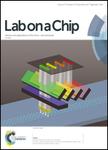版权所有:内蒙古大学图书馆 技术提供:维普资讯• 智图
内蒙古自治区呼和浩特市赛罕区大学西街235号 邮编: 010021

作者机构:Cornell Univ Dept Biol & Environm Engn Ithaca NY 14853 USA
出 版 物:《LAB ON A CHIP》 (微型实验室:化学与生物学的微型化)
年 卷 期:2006年第6卷第3期
页 面:414-421页
核心收录:
学科分类:0710[理学-生物学] 07[理学] 0804[工学-仪器科学与技术] 0805[工学-材料科学与工程(可授工学、理学学位)] 0703[理学-化学]
主 题:INTERDIGITATED ARRAY ELECTRODES MICROCHIP CAPILLARY-ELECTROPHORESIS VOLTAMMETRIC DETECTION MASS-SPECTROMETRY SYSTEMS CHIP MICROELECTRODE OPTIMIZATION IMMUNOASSAY
摘 要:A microfluidic biosensor with electrochemical detection for the quantification of nucleic acid sequences was developed. In contrast to most microbiosensors that are based on fluorescence for signal generation, it takes advantage of the simplicity and high sensitivity provided by an amperometric and coulorimetric detection system. An interdigitated ultramicroelectrode array (IDUA) was fabricated in a glass chip and integrated directly with microchannels made of poly( dimethylsiloxane) ( PDMS). The assembly was packaged into a Plexiglas(R) housing providing fluid and electrical connections. IDUAs were characterized amperometrically and using cyclic voltammetry with respect to static and dynamic responses for the presence of a reversible redox couple - potassium hexacyanoferrate (II)/hexacyanoferrate(III) (ferri/ferrocyanide). A combined concentration of 0.5 mu M of ferro/ferricyanide was determined as lower limit of detection with a dynamic range of 5 orders of magnitude. Background signals were negligible and the IDUA responded in a highly reversible manner to the injection of various volumes and various concentrations of the electrochemical marker. For the detection of nucleic acid sequences, liposomes entrapping the electrochemical marker were tagged with a DNA probe, and superparamagnetic beads were coated with a second DNA probe. A single stranded DNA target sequence hybridized with both probes. The sandwich was captured in the microfluidic channel just upstream of the IDUA via a magnet located in the outside housing. Liposomes were lysed using a detergent and the amount of released ferro/ferricyanide was quantified while passing by the IDUA. Optimal location of the magnet with respect to the IDUA was investigated, the effect of dextran sulfate on the hybridization reaction was studied and the amount of magnetic beads used in the assay was optimized. A dose response curve using varying concentrations of target DNA molecules was carried out demonstrating a limit o